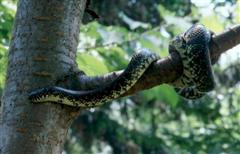Kingsnake - Eastern Black
Eastern Black King Snake Scientific Name: Lampropeltis getula niger
Sat, 12th July, 2025 - 6:16 am GMT
Sponsor Ads:

Alternative Name
Eastern Black King Snake Scientific Name: Lampropeltis getula nigerBasic Info
At maturity, the Black Kingsnake reaches a size from three to four feet. They have a black head, with occasional specks of white or yellow. As the name implies, the Black Kingsnake is mostly black. On the back are varying amounts of yellow and white speckling. Some specimens will have chain-like dorsal markings. Their underside is an even mixture of white and black.
Health
The Black Kingsnake is from a mild, humid climate. Their habitat should have light humidity, and a temperature around 80 degrees Fahrenheit. Breeding In the month of October, feeding should be stopped, and the temperature should be slowly reduced to around 60 degrees Fahrenheit. These conditions should be maintained for three months. The snakes should be placed together for short periods of time. When the two have copulated, they should be separated. An egg-laying chamber with damp vermiculite or sphagnum moss will be very helpful. After the eggs are laid, they should be removed, and kept at a temperature of 80 to 83 degrees Fahrenheit. Incubation takes 58 to 66 days. Juveniles will be seven to eight inches, and should be fed pink mice.Habitat
They usually inhabit grassy fields, lightly wooded areas, and cultivated fields.Behavior
The Black Kingsnake is a popular snake. Its exotic black color and medium size make it a very desired pet. Black Kingsnakes generally have a good temperament. While they are aggressive when first captured, the Black Kingsnake will calm down quickly. These snakes adjust rather well to captivity. Black Kingsnakes should have a medium sized habitat with moderate foliage and a branch for the snake to climb on.Origin
North AmericaHistory
The Black Kingsnake, or Lampropeltis getula niger can be found in the United States, in the states of Ohio, Alabama, Illinois, and some parts of Georgia.Common Foods
feeds on lizards, birds, snakes, eggs, frogs, lizards and small mammalsSponsor Ads:
Once upon a time, there were two Chinamen. Now look how many there are. -- Unknown
Kingsnake - Eastern Black
Coded by: BGID® | ALL RIGHTS RESERVED Copyright © 2000-2025
Disclaimer | Privacy | Report Errors / Contact | Credits
















